
Stroggos under SMC assault (Quake 4)
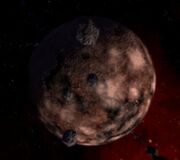
Stroggos from orbit (Quake II)
Stroggos is an extra-solar planet orbiting a distant star. Homeworld of the hostile cybernetic Strogg race, its an Earth-like planet similar in size, gravity, and atmospheric pressure. Stroggos has an atmosphere of similar composition to present day Earth's, enabling the world to support Human and other forms of organic life. Most of its known and charted surface comprises vast industrial wastelands, giving the planet its distinctive brown/orange color.
The planet was discovered to be the homeworld of the Strogg at some point between the events of Enemy Territory: Quake Wars and Quake 2, which eventually resulted in two large-scale Human invasions being launched in retaliation against it, aiming to end the Strogg threat comprehensively by global genocide. Despite extensive military operations being undertaken on the planet's surface, little of substance is known about the alien world, beyond the fact that the Strogg call it home. A ring of asteroids was noted to be orbiting the planet during the first invasion.
Stroggos has been stripped of much of its considerable resource wealth by the belligerent Strogg civilization, which have mined most of the metals, minerals, fossil fuels, and other raw materials that they could acquire (although some mining operations are still ongoing deep beneath the surface). Most life on the ecologically-ravaged Stroggos have suffered from one of several grim fates, including being forcibly appropriated by the Strogg either to become one of them or become their food, becoming mutated, or being driven to outright extinction.
Geography[]
Stroggos is an Earth-like world where the Strogg originated. Little data is available about the planet's precise composition, age, and other traits. It retains a similar atmosphere to that of Earth, though harsher, allowing unprotected humans to operate on the surface for extended periods of time. Stroggos has minor bodies of water and clouds, with the hydrological cycle persisting despite Strogg industrial activities[1]
Beyond that, it appears to be of a similar mass to the Earth, with a similar gravitational pull; it is highly geologically active, with an active planetary magnetic field. Its extensive moon system suggests that it may be a rocky world in the "Super Earth" category. The world's parent star type is not known, but the planet's orbit evidently falls within its habitable zone, allowing liquid water to persist on the surface, and life to develop and thrive therein.
Stroggos' atmosphere, being of a similar composition to that of the Earth, has been seen to exhibit water vapor clouds, indicating the ongoing presence of a global hydrologic cycle, in spite of the Strogg's worldwide industrial activities. That Humans find the atmosphere breathable today indicates that, for much of its living history, the world probably hosted a complex and rich biosphere, perhaps involving the global proliferation of oxygen-producing flora, both on the land and in its seas. The precise nature and makeup of this biosphere remains a tantalizing mystery, and there remains an outside chance that other natural processes may be the source of the world's nitrogen-oxygen atmosphere.
Because its atmosphere has not yet been rendered completely toxic by the Strogg, Stroggos may yet harbor an abundance of naturally occurring oxygen-producing life. Alternatively, the development of the Strogg's planet-wide industrial complex might have been more recent than previously thought. The prospect of the Strogg themselves sustaining the atmosphere artificially seems unlikely, given their thoughtless disregard for its ecology, but it yet remains a remote possibility.
What appear to be several small seas, of varying sizes, have been observed on the planet's surface. However, unlike on Earth, Stroggos' seas cover only a small amount of Stroggos' surface. It may be that these are the source of the world's oxygen, although this theory is, like so many regarding this hostile world, yet to be proven.
In Quake 4, Stroggos is shown to be similar in appearance to Mars, albeit with a thicker atmosphere. No green life or surface water is visible from space, though that may owe more to the position of the Earth's space fleet being on the wrong side of the world. Both the Quake 2 and Quake 4 depictions make it clear that Stroggos has no global oceanic system, and that is mostly a desert wasteland; perhaps an Earth-sized Mars.
Asteroid belt and rings[]
Stroggos has a ring system, or asteroid belt, in orbit about it, containing rocky objects of a significant size.
Hiding among the asteroids is a hidden retreat constructed by the Strogg race, utilized almost exclusively by their leader: the Makron. It's only accessible via a large teleportation device located on top of an important Strogg Palace on the surface of Stroggos.
The rings of Stroggos are something of an oddity, as the world possesses three moons, one of which itself possesses its own ring system. Considering that planetary rings tend from Human experience to be delicate, thin, icy structures, it's probable that Stroggos' ring system may in fact be the remains of a fourth moon, destroyed some time ago in an horrendous collision with another body - a fifth moon, perhaps? Whatever took place, the event might also have given birth to the distinctive impact craters Majoris and Minor on Stroggos' surface.
Moons[]
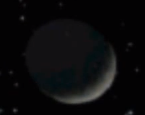
Stroggos has three known moons, each of which can be glimpsed in the introductory video of Ground Zero, none of which are yet known to have been named by the Strogg. To date, Humanity hasn't named any of them either. Little is known about any of them, as no surveys have taken place to date, though we can glean some basic information from the brief glimpse we have been afforded in the aforementioned intro sequence:
Of two of the moons, very little of note is definitively known. The first (right) seems at first glance to be similar in appearance to the Earth's own moon; small and grey. Its orbital path is probably somewhere in between the second and third moons. This is all we know. Nobody knows if the Strogg ever established a presence on its surface, or beneath it, as it has yet to be surveyed.
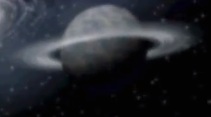
The second moon (left) seems to orbit closer to Stroggos than either of its sister moons, and is something of an oddball: it has its own ring system. Different in composition to Stroggos' rocky ring system, these rings are more than likely analogous to those of the gas giant Saturn, which are primarily made of dust and ice particles. How it has managed to maintain this ring system, given the constant and varying gravitational influences of its sister moons and their host planet, is unclear.
It is possible that a large impact created sufficient ejecta to generate the rings, and that they will disintegrate before long. Alternatively, it might be that the tidal forces continually exerted by its sister moons and parent world (Stroggos pulling in one direction and the moons in two others) have had a hand in maintaining ring stability, preventing them from collapsing in on the moon. It may also be that the aforementioned gravitational tidal forces render it subject to certain internal stresses; squeezing and stretching the interior, creating perpetual friction within it. This would generate a lot of heat and pressure, causing molten materials and gases to rise up through fractures in its crust and onto the surface. This gravity-driven volcanic activity might lead to regular volcanic or cryo-volcanic eruptions, throwing ice and dust into space, eventually coalescing into rings. Like the first moon, this one has also not been surveyed, so whether the Strogg have a presence there or not is unknown (though equally unlikely).
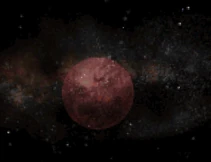
Of the third of the three moons (left & below right), much more is known, as it was visited by the Human Marine known as Joker during the events of The Reckoning. It seems to orbit farther out than the other two moons, and while its exact size is unknown, its gravity is about one-half to one-third of the Earth, which might make it a similar size to Mars or Mercury. It also possesses a thin atmosphere of unknown composition. Based on the moon's size and placement in the lunar system, as well as the vista visible from the Strogg moon base that Joker visits, it most likely has a predominantly carbon dioxide (which is relatively heavy) atmosphere, between a thousand and a million times thinner than Earth's own atmosphere (comparable to Pluto's atmosphere).
Like Mercury, it's large enough to have retained ice below the surface, and in the shadows where the sun's light cannot reach. The grey rocky crust of the moon is interrupted on occasion by extensive cave systems, the floors of which are sometimes found coated in a very slippery ice-like substance (most likely water ice, but possibly with some carbon dioxide ice mixed-in). The caves also exhibit stalactites and stalagmites, indicating ongoing liquid or mineral filtration processes, perhaps even some form of surface weather processes.
The little world may also be subject to similar tidal forces to that of the second moon (see: above). The moon's internal composition, and the stresses it's routinely subjected to, could generate sufficient core heat and motion to maintain a planetary magnetic field, which might explain why the atmosphere has not been entirely stripped away. This is a plausible explanation, as Mercury and Ganymede in our Solar System, which are about the same size as this moon, both have their own magnetic fields.

Close-up of the moon.

The rocky surface.
On and beneath the third moon's craggy surface, which shows all the hallmarks of tremendous geologic upheaval, the Strogg established a secret military base. The complex was extensive, containing a large military installation, a power plant, a suite of industrial facilities, and large subterranean hangars capable of housing an entire Strogg fleet. Its base commander was a Strogg Warlord in possession of a Jorg battle suit of identical design to that possessed by the Makron.
During the first Human invasion of Stroggos, the Strogg were readying a counter-fleet at the base, with the intention of launching a counter-strike against the Humans' orbiting space fleet, which was supporting their quickly deteriorating ground invasion. Still pinned in orbit by the Strogg's Gravity Well device, the ships were sitting ducks.
However, a lone Marine down on the surface of Stroggos, the last surviving member of his squad, uncovered invaluable intelligence regarding the counter-fleet's existence and location, stowed away aboard a Strogg cargo freighter heading to the Moon Base, hijacked it, and destroyed both the counter-fleet and the base in an impressive display of heroism.
The presence of a significant lunar system, and multiple ring systems, in orbit around a rocky planet like Stroggos, suggests that the Stroggos system may have more rocky material than the Earth's Solar System. However, moons are actually quite common, even in our Solar System; Jupiter, for example, has 79, while even tiny Pluto has five of its own. Venus and Mercury, which do not themselves have moons, have unique characteristics (namely, slow retrograde rotation and extreme closeness to the sun) which make having long-term moons impossible for them, but which wouldn't be expected to affect most Earth-like worlds.
Life On Stroggos[]
Stroggos is home to several species of alien life, the only documented examples of which are predatory and extremely hostile. They're believed to be the last remnants of what was once a planet-wide biosphere of similar diversity to that of pre-industrial Earth. One of the species is dominant over all the others; a fiercely-intelligent hive mind controlling a militarized civilization, which has polluted half the planet beyond recognition, causing the extinction of a high percentage of its complex life forms.
The Strogg[]
- Main article: Strogg
The Strogg are the dominant species on the planet Stroggos. An unusual race, unlike any in Earth's recorded histories, every Strogg can effectively be classed as military personnel. Their species have no civilian population whatsoever. In addition, they're not entirely organic creatures like Humans.
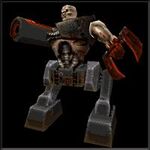
A Strogg warrior.
The Strogg are a species made up of configurations of artificially-melded organic bodies and mechanical augmentations. They're a race which does not know or understand the concept of "peace"; all they have ever known, to the best of Mankind's knowledge, is constant, unrelenting warfare. The Strogg's endless wars require an enormous military-industrial complex to sustain them. This has lead to the mass industrialization of Stroggos, along with its toxification and the destruction of much of the world's ecology.
The Strogg wage their brutal wars by scouring the Milky Way (and perhaps others too) for signs of worlds capable of harboring life, by utilizing advanced astronomical equipment. Once they locate a potential target, their forces are marshaled within fleets of enormous spaceships, which journey to the unfortunate world almost instantly with cutting-edge interstellar travel, looking for and, whenever possible, harvesting the organic life these worlds possess.
The harvested creatures are probably returned to Stroggos, where they're gruesomely experimented upon by Strogg scientists. As well as experimentation, captives might expect to be chopped up and broken down into amino acids or become food for the Strogg, known as Stroyent. They might also expect to be forcibly co-opted into the Strogg race via an horrific process known as Stroggification. The conversion process often involves amputations, injections, mutilation, extensive mechanical augmentations, and other traumatizing procedures.
Origins of the Strogg[]
It's unknown exactly when or how the Strogg civilization emerged, although there are many hypotheses circulating among the armed forces and the scientific community back on Earth. For example, it has been suggested that the Strogg might once have been wholly organic, like Humans, developing an obsessive reliance on technology and bodily augmentations which would one day bring the entire race under the commanding influence of a series of warlords.
An SMC Marine has theorized that they may in fact be the remnants of a race of artificially-created super soldiers, which took part in a terrible war centuries ago. Following the mysterious disappearance of their creators (which in itself could have happened several different ways), the Strogg race, rather than withering away in the absence of these creators, adapted and thrived; their old military hierarchy acting as a sort of political leadership. They would continue to do what they were created for - fighting endless wars and assimilating defeated races.
Another SMC Marine has expressed the opinion that the Strogg might actually be the next step in Human evolution, as Humanity has become increasingly reliant on technology, often at the expense of their own world's biosphere. If this view is widely held, it might prove to be the seed for future wars on Earth and its colonies between Human purists and augmented Humans.
Cities and Industry[]
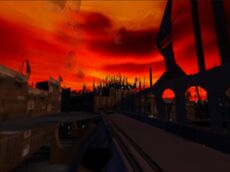
A look upon Cerberon, the Palace complex towering over it.
Located in the northern reaches of the enormous Crater Majoris, Cerberon is by far the largest, and so far the only identified city-like complex on the planet, and has thus been identified as the Strogg race's primary seat of power on the world. It acts as the military and political heart of the Strogg civilization. While many other extensive compounds and clusters of facilities have been observed across the planet's surface, none resembles a city in the same way in which Cerberon does.
- Main article: Cerberon
While the capital city houses many important military, communications, transportation, and industrial facilities -- such as the primary facilitator of Strogg interplanetary travel, a Black Hole Generator -- it also plays host to the Makron's seat of power: Cerberon's Palace. Seated on a naturally defensible rocky outcropping overlooking all the lands to the east, south, and west within the crater, it's from here that the Strogg race is officially directed in an endless interstellar war to conquer and assimilate more races, which is a basic necessity for their continued survival.
Far to the south of the main city and its defenses lies Crater Minor, its mountainous northern rim towering on the southern horizon of Cerberon, visible beyond the Big Gun on a clear night. It's home to several Strogg military bases, warehousing districts, Logistics Complex, and a Tactical Command Center.
To the south of Cerberon lies an extensive industrial region, which includes a major power plant, a large organic processing factory, Steedium or Thaelite mines, a Security and Prison Compound, and an extensive warehousing district. This region is defended from ground assaults by a grid of deadly laser fences, which stretches around the entire industrial and capital sectors.
There are many other industrial complexes scattered across the surface and sub-surface of the planet, serving all manner of different purposes; e.g. Stroggification, Stroyent production, mining, toxic waste disposal, etc. They are each critical to the good operation of the Strogg war machine, although there is probably a degree of redundancy built into their military-industrial complex. for example, if one plant goes down another can continue operations and few resources are wasted.
Extra-Terrestrial Activities[]
The Strogg have conducted many exploratory, fact-finding, and colonization operations beyond the surface of their polluted homeworld.
An extensive off-world colony was located on one of Stroggos' trio of moons. Within was an enormous complex, featuring a power plant, surface and subsurface shipyards and hangars, even industrial facilities; all indicating the Strogg presence to be long-term, if not permanent. It was especially significant because its hangars and shipyards housed an entire counter-fleet of Strogg ships preparing to launch retaliatory attacks. Its significance was further identified when its Commander turned out to be a Warlord (and potential future leader of the Strogg race) utilizing a battle-suit of identical design to the then-Makron. The base was later destroyed.
The Strogg also established a secret base of operations on an
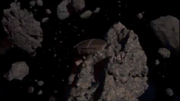
asteroid in their planet's belt. It was utilized almost exclusively by the leader of the Strogg race, the Makron, although for what purpose isn't clear. It may have been that the isolated location was a gathering place for the Strogg Warlords when a new Makron was due to be chosen. It was only accessible via a powerful teleportation device located on top of the Makron's Palace on the surface of Stroggos. This base was destroyed by a Human Marine as well.
In addition, there was at least one free-floating Strogg space station in orbit around the planet. A large manned communications satellite, it probably relayed communications between Stroggos and their various space fleets, moon bases and other off-world operations, as well as facilitating general planetary communications. Unlike the two prior Strogg off-world sites, this facility was not itself destroyed, although it was rendered non-functional when its communications dish was ejected and blown up.
The Strogg Invasion of Earth[]
- Main article: War against the Strogg
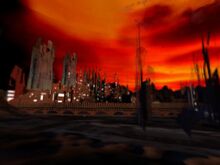
Stroggos at ground level
The Strogg invaded the Earth in the middle of its 21st Century period, taking its inhabitants completely by surprise. Their large invasion fleet arrived in orbit over the world seemingly out of nowhere, and its ground forces quickly proved themselves a dire threat to the existence of Mankind.
The Humans were more resilient than expected, however, and fought the Strogg to a standstill, prolonging the conflict for years before eventually forcing the aliens off-world and back to their home world.
During the war, the Humans discovered how the aliens had traveled to the Solar System from their home world of Stroggos; via an interplanetary gateway known as a Slipgate. Thus began preparations to exact revenge on the Strogg, which would eventually take the form of the First Invasion of Stroggos; large assault force sent through gateway to the aliens' home planet to defeat them once and for all.
The Human Invasion of Stroggos[]
Thanks to the Human commanders' patchy knowledge of Stroggos' defenses, the mainstay of the Strogg's powerful planetary defense systems, dubbed the "Big Gun", quickly routed the Human invasion, with only a few handfuls of marines surviving the initial landing operation and proceeding hours. Most of the survivors were captured and prepped for Stroggification in various Strogg factories, or turned into Stroyent to feed the alien armies. Despite this, several marines remained at large on the world, one of whom was able to complete all four objectives of "Operation: Alien Overlord" single-handedly, beating all the odds.
With the Strogg leader dead and the Big Gun destroyed, the Humans were able to launch a full-scale ground attack on the planet. Human Intelligence soon located a facility critical to the Strogg war effort, dubbed the Nexus Hub. Destroying this facility would cripple the Strogg's communications network. The first assault on the complex was crushed, thanks to the timely intervention of the freshly promoted Makron. This defeat was followed up later by a more successful second attack, this time on the Nexus' core itself. The Humans were only able to launch the operation by taking advantage of a recently partially-Stroggified marine named Matthew Kane, rescued before the conversion process was completed. By sole virtue of his partial Stroggification, he was able to reach the Nexus itself and destroy it, assassinating the new Makron, in the process, supposedly crippling the Strogg war machine.
With their entire communications network knocked out, the Strogg are now thought to be in a desperate state of disarray; their ground and air forces suddenly isolated from the global communications network, no longer able to respond to threats in the timely or coordinated fashion necessary to chase the Human armies off-world.
The Strogg have recovered from major setbacks before, however, so it wouldn't be wise to assume that their war is lost just yet.
Strogg Extinction?[]
According to the ending of Ground Zero, an explosive planet-wide chain reaction occurred as a result of the destruction of the Gravity Well, supposedly killing all life on the planet's surface. This, however, contradicts the plot of Quake 4 and is therefore accepted to be either non-canonical, or simply hyperbole from the Deimos' crewman in communication with the Marine (Stepchild) who announced said extinction.
It can be assumed, therefore, that while the chain reaction caused major damage on the planet, the vast bulk of the Strogg forces (and their most important facilities including the Nexus) survived.
Other Life on Stroggos[]

Mutated alien wildlife discovered on Stroggos
As well as the dominant Strogg civilization, with their citadels, installations, and planet-wide industrial complex, Stroggos is also home to other forms of life, inhabiting a severely stunted biosphere. These life forms primarily dwell in isolated swamps and canyon systems; regions either unsuitable for Strogg development or being used by the Strogg for less invasive purposes. It's thought that, prior to the Strogg's devastation of the global ecology, the world must have appeared similar to the Earth in many respects. However, it's possible that many of Stroggos' original fauna still inhabit untouched regions located across the planet. Due to the planet's size, there may exist unpolluted areas which allow the native wildlife a refuge from the Strogg's industrial civilization.
As of now, most wildlife on Stroggos has suffered from one or more sad endings, including:
Mutation: Those hardy native species which still survive on Stroggos, but which haven't been driven to extinction or been co-opted as food for fresh warriors, have, to a greater or lesser extent, become mutants. These mutations, caused by long-term exposure to mutagenic pollutants in the environment (deriving from the Strogg's industrial activities), allow those creatures to which the mutations aren't crippling or otherwise fatal (likely a small percentage of the total affected populations) to survive in Stroggos' inhospitable wastes.
Side Note: Given the complete absence of data on Stroggos' pre-industrial biosphere, and the lack of studies (particularly in the field of genetics) on the remaining few non-cybernetic species, it's not possible to determine the precise extent to which mutations have altered the genetic codes and/or physical appearances of the affected creatures. That said, it's not unreasonable to believe that the surviving wildlife of present-day Stroggos bears little (if any) resemblance to its pre-industrial forms.
Stroggification: This is perhaps the most harrowing fate to befall the native fauna of Stroggos: Being converted, through a long process of extensive and highly invasive surgical procedures -- e.g. implantations, injections, amputations, transplants, and so on -- into conscripted units of the Strogg military.
Stroyentification: Anything which wasn't mutated beyond usability, successfully transferred into the ranks of the Strogg military machine, or driven to extinction has probably ended up as Stroyent - the staple foodstuff of the Strogg race, which also have healing qualities for the Strogg.
Extinction: Any lifeforms which were of no use for the Strogg's military complex, couldn't adapt to survive in the harsh industrial wastelands, and weren't subjected (or couldn't survive exposure) to mutagenic pollutants, almost certainly died out entirely many years ago.
So far, only three species are encountered which haven't been incorporated into the Strogg military, and each has suffered from their hard quest to survive life on Stroggos:
1. The Mutant, as its name suggests, is a species which has become mutated beyond all recognition. It may once have appeared similar to a Bear or Great Ape, though that is just speculation. The culprit for their mutations is almost certainly toxic pollution generated by the Strogg's military/industrial complex.
2. The Gekk is a social species similar in appearance to an almost lizard-like primate, and prefers to live in water-logged swamps or canyon systems. They're as hostile to the presence of the Strogg as they are to Humans, and are not regarded as Strogg military units. They're still a danger to anyone unfortunate enough to encounter them alone. The level of mutation they have undergone isn't clear, it may well be minimal. However, their bio-luminescent acidic spit may be a product of less obvious internal mutations.
3. The Barracuda Shark is a shark-like species known for its viscousnes, territorial nature, and pack-hunting abilities. They appear to infest many of the waterways of Stroggos, even somehow managing to make their way into heavily guarded Strogg facilities. Traversal of the waters on Stroggos is a hazardous affair at best, thanks to these creatures. The level of mutation they have undergone isn't clear; their absolute hostility to intruders may be a sign of mental changes undergone after exposure to certain pollutants.
The Strogg have been so per-occupied with industrialization and constant warfare, that their species have comprehensively ruined the world which gave them (or their creators) life. Perhaps this was a decisive factor in their race becoming so completely dependent on technology.
Geography and Climate[]
Geography[]
According to most of Mankind's more recent geological surveys, as well as data extracted from war-time surveillance and reconnaissance sorties, Stroggos is a largely barren world dominated from pole to pole by vast deserts, usually grey and/or brown in color, of a presumably industrial (rather than natural) origin.
Breaking up the silent monotony of the industrial desert landscapes are a wide variety of geological features; such as large mountain ranges, which run for thousands of miles across the surface, and deep canyon systems splitting through the crust. These topographical features hint at internal planetary processes not dissimilar to those of Earth, or indeed the early Mars.
Scoring the desolate wastelands are the global transportation networks built by the Strogg race, which can all be counted on to lead directly to any number of dense complexes of utilitarian military and industrial buildings -- many of which have been identified serving as factories, communications centers, power plants, waste disposal facilities, and more. These complexes, appearing weathered from without (though not at all dilapidated within), are often found nestled into the landscape, perhaps so as to be harder for enemies to locate, perhaps to be better protected from Stroggos' weather. The Strogg population, all of which are classified as military personnel, reside within these fortified complexes and military installations.
In addition to the unrelenting deserts, long mountain chains, deep canyons, and military-industrial centers, the inhospitable world still manages to retain several small open seas, perhaps by the Strogg's own design (their fission-based energy infrastructure and global industrial complexes must require unfathomably huge quantities of water to function). These seas are presumed by some exo-geologists to be the remnants of much larger oceanic bodies, now all but drained away by generations of Strogg industrial activities, although no studies or surveys have been undertaken to corroborate their hypotheses.
The seas are lined with swamp-lands, occasionally interrupted by industrial centers, and provide a much-needed break from the world's otherwise constant dull grey-brown deserts. Both the swamps and the seas still manage support much-reduced biospheres.
Craters[]
The Strogg capital city, and many surrounding military-industrial installations, including the planetary defense systems, are constructed within the bounds of an enormous impact crater named Crater Majoris, the rim of which has not yet managed to erode away. Its interior is largely dominated by flat plains, occasionally divided by deep canyons, large rocky outcroppings, and even other craters. The southern half of Crater Majoris is occupied by a second impact crater, dubbed Crater Minor, the rim of which is only partially evident, despite being younger.
The Strogg use much of the greater Crater Majoris area to house important communications relays, defense systems, industrial and mining facilities, other military complexes and their capital city, although even with all these installations in place there is still much ground that has not been built on. The second crater, Minor, is used to house storage complexes, small military bases and command posts. It is partially flooded, its waters probably being drawn up to feed Strogg industry, mining and construction works.
Natural Defenses[]
Stroggos' geographical make-up includes many features familiar to the invading Human forces. For example, mountain ranges large and small are commonplace on the world, although most are apparently as barren and desolate as the rest of the surface. The planet's geography also includes many other familiar features, such as caves, ridges, cliffs, crater rims, rocky outcroppings, canyons, springs, rivers, volcanoes, rift valleys ,and there are even signs of tectonic plate activity.
All of these features of the terrain and more are, like so many other things, utilized by the ever-resourceful and adaptable Strogg in many of their operations, indicating that the Strogg are no strangers to incorporating naturally occurring features of the landscape into their defensive apparatus.
The evidence of geological activity, both ongoing and past, is therefore plentiful.
It's also clear that many of these natural features of the landscape have undergone extensive weathering processes, suggesting an active global weather system.
Climate[]
Information on the climate of Stroggos is limited, primarily to data useful to the Human military forces. The weather which has thus far been experienced by these forces can generally be described as "very calm", and although Strogg facilities bear evidence of extensive weathering, their likely ages, combined with evidence of mild neglect, suggests that the weather was not expected to be harsh on them even when they were constructed.
Despite the weather's apparent calmness, however, Stroggos is still an industrial desert world, and as such, dust storms remain an ever-present possibility, and thick cloud formations indicate rainfall must happen somewhere at some point, though none have yet been witnessed. All of this leaves little reason for S.M.C. commanders to worry about conducting operations in harsh weather.
Part of the reason for there being so little evidence of rainfall on Stroggos, for it being a desert world, is that the planet is slowly drying up. Strogg monopolization of global water supplies in their construction works, Stroyent systems, and other areas are thought to have been another contributory factor in the large-scale desertification and depopulation of the world.
It's also possible that Stroggos actually used to be as water-covered as Earth, and that its ancient oceans and seaways, once a dominating feature of the planet, have simply been sucked dry by the Strogg machine, such is the massive scale of their industrial complex. Humans should still be able to extract and decontaminate moisture from the air to resupply, however.
The monopolization of Stroggos' water supplies has another knock-on effect; it halts the world's tectonic plate system. The Earth's oceans are believed to be a critical factor in its ongoing tectonic activities, lubricating plates as they are subjected and so on, and there is no reason to believe this process is alien to Stroggos. With its large oceans disappearing at the hands of the Strogg, however, Stroggos' plates may already have ceased to move. While ongoing underground geological processes such as the formation of volcanoes will continue, the plumes of magma that create them will no longer by hindered by plate movements, and volcanoes the size of Olympus Mons or talls may begin appearing across the surface, the climatic effects of which are unknown.
Civilization[]

The only "cultural" icons on Stroggos: banners
- Main article: Strogg
There is no record of any other civilization inhabiting Stroggos other than the Strogg themselves. They have displayed no interest in cultural development, as all efforts are placed in military, scientific, medical, and industrial efforts due to the barbaric priority of conquering other cultures. The Strogg civilization is largely an Earth parallel, although far more advanced and without any known development by the species in ethics, philosophy, or religion. Clearly, the Strogg lacked key pressures that contributed to human evolution. Altruism never evolved, so remorse, pity, and friendship were never Strogg traits, or are at least long forgotten, in spite of their natural body design and physiology being similar to ours (i.e. red blood). This could also be explained by the assumption of some Humans that the Strogg actually never were a biologically evolving species, but rather created by another unknown race for the sole purpose of warfare, which would require no culture or ethics. Nearly all life on Stroggos is cybernetically augmented. The only exceptions are the mutants discovered in Quake 2.
Society[]
Note: the following section in itallic is tangential and contains too much conjecture - delete or move somewhere else? In terms of society, The Strogg have proven to be incredibly complex. The evidence for this is explained during Quake 4, in an intelligence briefing to Rhino Squad before Operation: Last Hope. All imperative functions and aspects of the Strogg machine are housed within the Core, a huge and immensely well defended tower. This housed the Nexus, although whether this was actually a sentient creature in itself, controlling the Strogg as a manifestation of its malign will (which would suggest the Strogg evolved as a species up to their current state) or perhaps a more 'primitive' supercomputer merely making simple logic calculations or even executing an old programmed function (which would lend credence to the theory that the Strogg were created by another civilization as super-soldiers) is unclear; indeed, given the incomprehensible technological advances of the Strogg it could be a combination of these or something altogether different. What is clearer is that this Core appears to make all decisions to do with the Strogg's ongoing existence, utilizing the processes of the three other towers.
These three supporting towers appear to have been built to simultaneously provide multilayered defense to the Core as well as being themselves utilized for important tasks in the ongoing processes of the Strogg civilization. These towers were Networking, presumably a central point linking together all Strogg computing and combat activities; Data Storage, presumably a vast store of Strogg data collected on all forms of technology, perhaps including that of conquered civilizations, intelligence and all other relevant information for the Strogg civilization and finally the Processing Center, which would presumably process all the vast amounts information gathered and send anything considered important to the Strogg war machine to Data Storage. This tower might could also process information to be distributed via Networking to the Nexus and from there to Strogg infantry units and commanders.
However, this is speculation; however, given the Strogg's highly technologically advanced nature exactly what processes and tasks these towers accomplished might never be ascertained without knowledge of the technology itself. All of the processes within these towers, given the nature of the Strogg's highly advanced technology, are assumed to have been far beyond computing powers of human creations.
Again speculating with the use of analogy, it is perhaps the case the the Strogg have used or even somehow copied the highly complex nature of organic brain matter, which similarly to the layout of the towers central to the workings of the Strogg and corresponding vastly advanced technology has vast networking, storage and processing abilities. If conceptualized in this way, the entire Strogg war machine can be imagined to be a single organism, with those unfortunate organisms captured robbed of the ability to think independently and adapted to service it. The brain of this organism is the towers and the Core. This is also suggested by the nature of the inner working of the towers, which as Matthew Kane and other marines explored them proved to be far beyond the capabilities of human technology. This is also reflected by the fact that all towers were well-fortified in a natural defense, with the Core tower itself deeply dug into the ground, perhaps analogous to a human skull.
This inevitably begs the question of whether this system, society or whatever such term best describes the Strogg is some sort of pinnacle of evolution or the creation of another, long lost civilization for the purpose of generating an army, or perhaps even a blend of these two concepts. Unfortunately a concrete answer is likely to never be found, given the hostile nature of the Strogg making destruction of this incredible technology almost certainly likely before it can be properly understood.
The effects of the events in Quake 4 upon the Strogg are unknown, although it is reasonable to assume that the destruction of the Nexus will have had a savagery effect upon the Strogg, disorientating its workings and society and leaving its drones without instructions, a severely disruptive development having originally been automatons controlled simultaneously and directly by the Nexus, analogous to a human operating its extremities. Future games may explain further the results of this but until such information is released only speculation on the workings of the Strogg is possible, but remain currently unknown is true or not.
Behind the scenes[]

Original: The Stroggos of Quake 2.
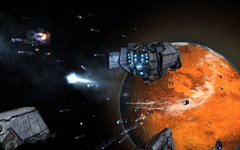
Revisited: The Stroggos of Quake 4.
The world has been portrayed slightly differently in each game. Quake 2 portrays Stroggos as a grey-brown planet possessing a ring system of orbiting asteroids and a great deal of smaller debris, all of which might endanger incoming craft, as well as several moons, with no evidence of civilization visible from orbit. In Quake 4 the moons and asteroids are not visible. Across the orange surface of Stroggos, the industrial wastelands of the Strogg Empire is clearly visible from space.
Quake 2 portrays the world's skies as being a fiery orange-red color, with clouds appearing as ominous black splotches overhead, while the asteroid belt often visible. The planet's sky in Quake 4 is shown with none of this distinctive coloration, and is instead a polluted, often grey and cloudy sky, with Earth-like hues of blue when the sky is clear. This is more realistic, as the world's atmosphere is breathable to Human life, so must be a comparable mixture of nitrogen and oxygen.
Reconciling both interpretations of the world can be difficult, though it has been speculated that the planet might undergo different phases -- it is, for example, unknown if the planet is heated by a singular or multiple suns, even though only one is visible at any given time. If Stroggos is part of a binary star system, and its parent stars are of different varieties, then this theory might provide a reasonable explanation for the different lighting or atmospheric conditions shown in Quake 2 and Quake 4.
A hypothesis for the absence of space debris and the ring system, seen in-orbit around Stroggos in Quake 2, has also been put forward: The Strogg might have devised an artificial means of sustaining the ring of space debris as another defensive measure to guard against invasion, which was somehow disabled by the Humans at some time between the events of Quake 2 and Quake 4, leading to the ring's spectacular disintegration, although such a significant event is never mentioned, or even hinted at, making it an unlikely prospect. At the same time, the Strogg may have erected many small and well hidden bases (like the one on board which the Makron was killed), that the Humans would have chosen to destroy or destabilize all asteroids with their large fleet already in orbit at the time of Quake 4, rather than risk having their supply routes interdicted by the enemy.
Another possibility could simply be that they do exist in both games, but the size or placement of the moons and ring were exaggerated in Quake 2 for dramatic effect so that they all could be easily visible. Real-life pictures taken of Earth by orbiting satellites which also contain the moon are actually relatively rare due to the moon's distance from Earth. Similarly with pictures of Mars, Phobos and Deimos are quite tiny and dark, and easily missed. And of the rings in our Solar System, only Saturn's are easily seen at a glance. The surface of Stroggos could likewise be interpreted as being more or less similar in color to that of Mars or the desert regions of Earth.
References[]
- ↑ Quake II Remastered, Concept Art: "Stroggos' atmosphere is similar in composition to that of the Earth and has bodies of water and water vapor clouds, indicating that a hydrologic cycle persists, in spite of the Strogg's industrial activities. While many of the levels would feature water in environments, this part of Stroggos was not really explored in the game's levels."

